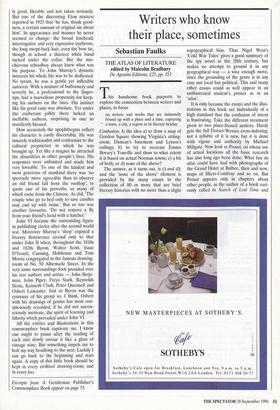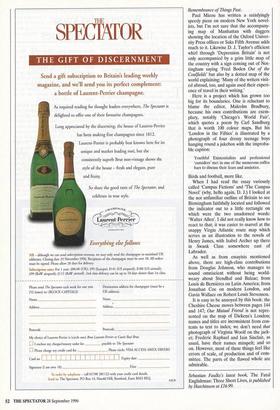Writers who know their place, sometimes
Sebastian Faulks THE ATLAS OF LITERATURE edited by Malcolm Bradbury De Agostini Editions, f25, pp. 352 This handsome book purports to explore the connection between writers and places, to focus on writers and works that are intimately bound up with a place and a time, capturing ' a town, a city, a region in its literary heyday.
Confusion. Is the idea a) to draw a map of Gordon Square showing Virginia's sitting- room, Duncan's basement and Lytton's railings; b) to try to recreate Emma Bovary's Yonville and show to what extent it is based on actual Norman towns; c) a bit of both; or d) none of the above?
The answer, as it turns out, is c) and d); and the 'none of the above' element is provided by the many essays in the collection of 80 or more that are brief literary histories with no more than a slight
topographical bias. Thus Nigel West's 'Cold War Tales' gives a good summary of the spy novel in the 20th century, but makes no attempt to ground it in any geographical way — a wise enough move, since the grounding of the genre is in any case not local but political. This and many other essays could as well appear in an unillustrated student's. primer as in an `atlas'.
It is only because the essays and the illus- trations in this book are individually of a high standard that the confusion of intent is frustrating. Take the different treatment given to two place-fixated authors. Hardy gets the full Dorset-Wessex cross-indexing; not a syllable of it is new, but it is done with vigour and authority by Michael Millgate. Now look at Proust, on whose use of actual locations all the basic research has also long ago been done. What fun an atlas could have had with photographs of the Grand Hotel at Balbec, then and now, maps of Illiers-Combray and so on. But Proust appears only in chapters about other people, as the author of a book vari- ously called In Search of Lost Time and Remembrance of Things Past.
Paul Micou has written a satisfyingly speedy piece on modern New York novel- ists, but I'm not sure that the accompany- ing map of Manhattan with daggers showing the location of the Oxford Univer- sity Press offices or Saks Fifth Avenue adds much to it. Likewise D. J. Taylor's efficient whirl through 'Depression Britain' is not only accompanied by a grim little map of the country with a sign coming out of Not- tingham saying 'Fred Boden Out of the Coalfields' but also by a dotted map of the world explaining: 'Many of the writers visit- ed abroad, too, and again used their experi- ence of travel in their writing.'
Here is a project which has grown too big for its boundaries. One is reluctant to blame the editor, Malcolm Bradbury, because his own contributions are exem- plary, notably 'Chicago's World Fair', which quotes a poem by Carl Sandburg that is worth 100 colour maps. But his 'London in the Fifties' is illustrated by a photograph of four dressy teenage boys hanging round a jukebox with the improba- ble caption:
Youthful Existentialists and professional 'outsiders' met in one of the numerous coffee bars to discuss their fears and anxieties.
Birds and football, more like.
When I had read the essay variously called 'Campus Fictions' and 'The Campus Novel' (why, hello again, D. J.) I looked at the not unfamiliar outline of Britain to see Birmingham faithfully located and followed the indicator out to a little rectangle on which were the two unadorned words: 'Walter Allen'. I did not really know how to react to that; it was easier to marvel at the snappy Virgin Atlantic route map which serves as an illustration to the novels of Henry James, with Isabel Archer up there in Swank Class somewhere east of Labrador.
As well as from essayists mentioned above, there are high-class contributions from Douglas Johnson, who manages to sound omniscient without being world- weary about Stendhal and Balzac; from Louis de Bernieres on Latin America; from Jonathan Coe on modern London, and Gavin Wallace on Robert Louis Stevenson.
It is easy to be annoyed by this book: the Cheshire Cheese moves between pages 144 and 147; Our Mutual Friend is not repre- sented on the map of Dickens's London; names and titles are inconsistent from con- tents to text to index; we don't need that photograph of Virginia Woolf on the jack- et; Frederic Raphael and lain Sinclair, as usual, have their names misspelt; and so on. However, most of these things feel like errors of scale, of production and of com- mittee. The parts of the flawed whole are admirable.
Sebastian Fauna's latest book The Fatal Englishman: Three Short Lives, is published by Hutchinson at f16.99.



















































































 Previous page
Previous page